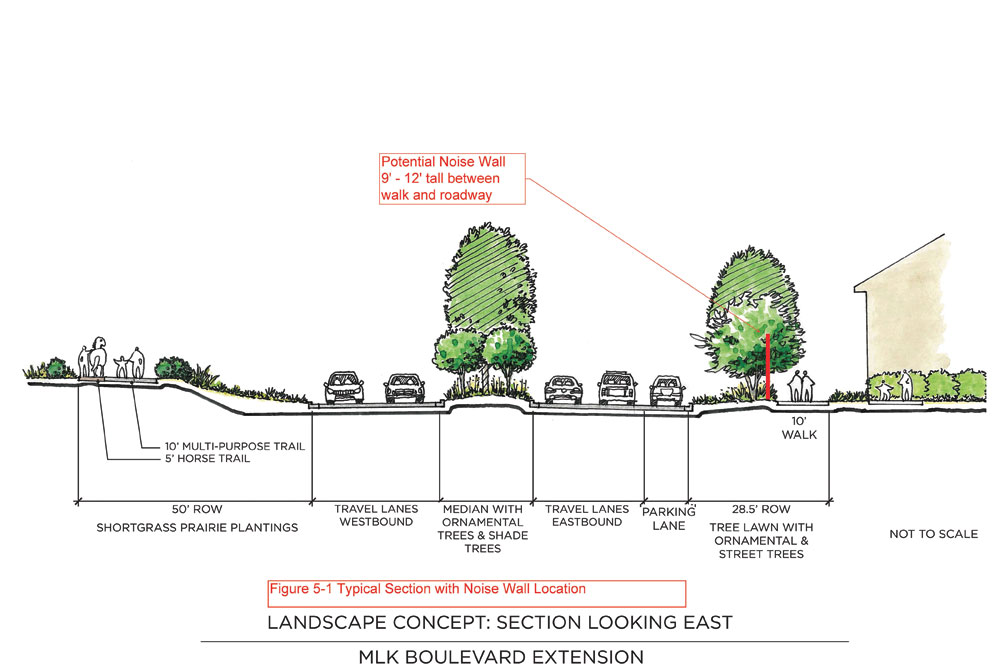
The extension of Martin Luther King Blvd. in Stapleton has been delayed for perhaps a full calendar year. Originally slated to begin construction this past summer, Denver Public Works (DPW) says construction is “now anticipated to begin spring/summer 2017.” DPW attributes the delay to a “combination of design changes, new federal and state noise regulations, and a 2011 environmental document that is now out of date.” Unresolved at this point is whether the new regulations will require a noise wall to protect adjacent residential properties.
The MLK extension will run from Havana St. to Peoria St. and adds two through lanes in each direction along with medians and detached parallel bicycle/pedestrian facilities. On the existing stretch of MLK from Iola St. to Moline St., the project adds one lane in each direction.
The $16 million project is subject to state and federal requirements because it will be funded in part with federal monies. A combination of updated traffic volume modeling and new noise regulations adopted by the Colorado Department of Transportation (CDOT) has “produced new findings that noise walls may be both reasonable and feasible” along one stretch of MLK, according to Nancy Kuhn, DPW communications director. Denver is disputing the “feasibility” of the noise wall and Kuhn says, “We are discussing with CDOT/FHWA (Federal Highway Administration) right now and hope to have a resolution within a couple of weeks.”
The walls under consideration would be located along the south side of the new MLK alignment from Havana to Moline St. where there are existing residential properties. Kuhn said wall height is dependent upon the level of noise to be mitigated and looks at factors including distance from the roadway to each house and the amount (decibels) of expected traffic noise. Because of the early stage of evaluation, any noise wall materials or appearance have not been determined. Cost is undetermined at this time but, if ultimately required, would have to be absorbed by Denver.
Formally, consideration of a noise wall has arisen through a 2016 Environmental Assessment (EA) reevaluation that is updating the original analysis done in 2011 as Denver prepared its application for federal funding. The 2011 EA found that noise walls were not feasible due to space limitations. In its discussions with CDOT and FHWA, Denver is making that case again along with these arguments:
- A solid noise wall would preclude direct access to the planned RTD bus stops near Kingston St. and Moline St.
- The wall would preclude direct access to the parking spaces along the south side of the extension.
- The wall would shade the sidewalk, resulting in the potential for icing during winter months.
- An impact on views.
- Potential for the walls to be graffiti targets.
Kuhn says the “next step is whether CDOT and FHWA concur with Denver. If they don’t agree and feel that the potential for noise walls is both feasible and reasonable, then the next step would require a vote of the affected property owners, where more than 50 percent of those homeowners/residents must vote for a noise wall. A vote will only take place if CDOT/FHWA do not agree with the City and County of Denver that noise walls are not feasible/reasonable. That is the next step of the evaluation process and we are waiting to hear what CDOT/FHWA have to say.”
Extension of MLK has long been sought by Denver as a necessary addition to the city’s arterial street system. This “regionally significant” project will connect Stapleton to the Anschutz Medical Campus and provide walkers and bikers easy access to the FasTracks commuter rail and light rail stations. MLK currently accommodates an average of 15,000 vehicles per day with a projection of 29,000 average daily trips (ADT) by the year 2040.



A wall will only encourage faster speeds on MLK, blocks views, and will encourage graffiti. Walls are for freeways and Aurora. I live on MLK Blvd west of this area and the answer is better speed mitigation, not noise walls.
This is a fantastic idea for this stretch of MLK. This street is already very loud, anything to help would be greatly appreciated. In addition to the noise reduction this will provide many parents some piece of mind with the added safety benefits. Build the wall! 😉
How about don’t make the road so wide, then the traffic won’t be so loud?
Streets should be connecting people. If you have to put a wall in front of it, you’ve failed at designing the street.